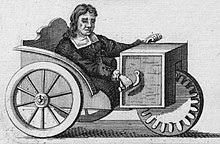Stephan Farffler
 From Wikipedia the free encyclopedia
From Wikipedia the free encyclopedia
Stephan Farffler | |
|---|---|
 | |
| Born | November 12, 1633 |
| Died | October 24, 1689 (aged 56) |
| Nationality | German |
| Occupation(s) | Watchmaker, inventor |
Stephan Farffler (1633 – October 24, 1689[1]), sometimes spelled Stephan Farfler, was a German watchmaker of the seventeenth century whose invention of a manumotive carriage in 1655 is widely considered to have been the first self-propelled wheelchair. The three-wheeled device is also believed to have been a precursor to the modern-day tricycle and bicycle.[2]
Farffler, who was either a paraplegic[3][4] or an amputee,[5] also created a device for turning an hourglass at regular intervals and added chimes to the clocktower of Altdorf bei Nürnberg.[6]
the German WiKi says: either paraplegic as a result of an accident when aged three years;[7] others describe him as a human with crippled legs [8] („verkrüppelten“ - which could also mean disfigured or malformed and this might, for onlookers, be an accurate description when, as said, the accident happened at a very young age which would likely impair normal growth of the affected limbs)
See also
[edit]References
[edit]- ^ "A Brief History of the Tricycle". retropedalcars.com. 2012-12-02. Archived from the original on 11 January 2013.
- ^ "Medical Innovations - Wheelchair," Science Reporter, Volume 44, 2007, 397.
- ^ Jane Bidder, Inventions We Use to Go Places (London: Franklin Watts, 2006, 18)
- ^ Rory A. Cooper, Hisaichi Ohnabe, and Douglas A. Hobson, An Introduction to Rehabilitation Engineering (Boca Raton: CRC Press, 2007, 131)
- ^ Clive Richardson, Driving, the development and use of horse-drawn vehicles (B. T. Batsford, 1985, 136)
- ^ Frederick James Britten et al., Britten's old clocks and watches and their makers (E. Methuen, 1973, 391)
- ^ Johann Gabriel Doppelmayr, Historische Nachricht Von den Nürnbergischen Mathematicis und Künstlern, Nürnberg 1730, S. 302
- ^ Fabian Zilliken: Die Evolution des Fahrrads - Von der Laufmaschine zum "Custom(izing)" Artefakt, 2012, S. 10